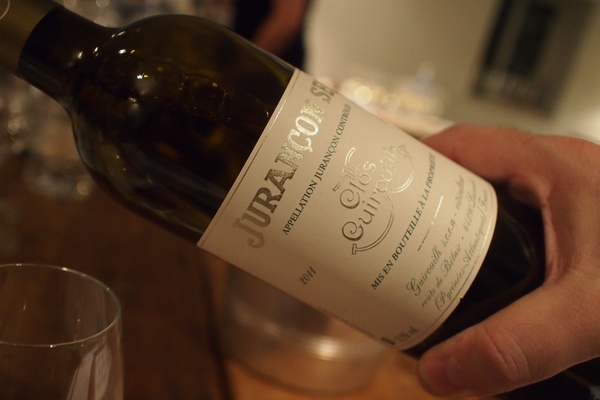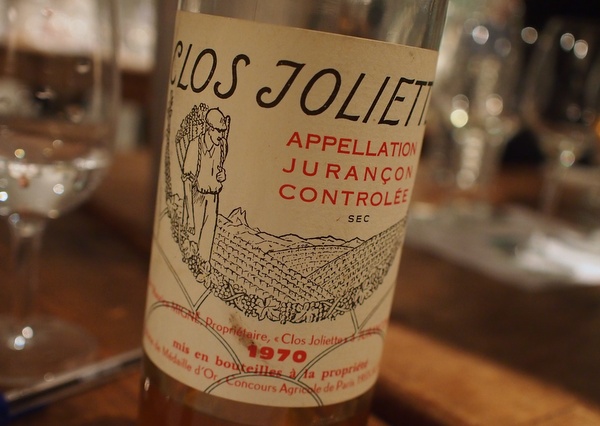|
Jurançon
Sec tasting
An exploration of the various styles at The Sampler

November
2013
Jamie
Hutchinson (of The Sampler) and his partner Jess (an MW student) have a
grand plan. They want to make wine. But rather than target the usual
suspect list of wine regions, they have set their sights on Jurançon,
and their dream is to make a Jurançon Sec.
This
grand vision is something that they are sharing at an early stage, and
it is going to be fascinating to watch it come to fruition. As part of
the project, they held an exploratory tasting of Jurançon Sec, which
they kindly invited me to, along with a number of their customers and
friends. ‘Most of these wines we have never tried,’ shared Jamie.
‘We
both wanted to make a wine, as well as selling wine.’ Which wine? ‘We
worked out an area we were both excited by, Jurançon, and the Petit
Manseng grape in particular,’ says Jamie.
There are five white varieties in the region,
and the three common ones are all related: Petit Manseng, Gros Manseng
and Petit Courbu (the other two are Camaralet and Lauzet). Petit
Manseng is the number one variety. It has a savoury aspect, with notes
of wax, honey, lanolin and salt. It is rich, but it ages well, and it’s
also a grape that keeps its acidity all the way through the ripening
process. There is great flexibility in terms of winemaking.
But
what style should they be making? For the dry wines, no one has done
anything much of interest. ‘No one has defined the style for the
appellation,’ says Jamie. This is one of the motivtions for holding
this tasting, to allow Jamie and Jessica to decide which sorts of wines
they’d like to make.

Another
advantage with Jurançon is that it’s dead easy to get to, with cheap
flights from London City airport to Pau, which is close to the region.
Add in the fact that the locals are friendly and welcoming, and it’s a
very attractive prospect. ‘We don't want to lose money on this
project,’ shares Jamie, ‘but neither are we planning to make a living
from it.’
They'd
like to buy a small established vineyard of 1–2 hectares. They’d be
growing mostly white grapes but would also like to plant Syrah if the
site is suitable. They’d aim at low yields, with a focus on quality.
Officially
there are 25 recognized terroirs in the region, but just three that are
significantly different.
1
Monein – rolling hills (easy to work), lower altitude, warmer climate
and soils of clay plus galets. The majority of famous wines from the
region since 1960 have come from this terroir. Gives a soft, rich style.
2
Lasseube – highly fractured mixture of soft and hard rocks called
flysch. Moving toward the mountains this is poor, well-drained soils,
and these sites are cool and late ripening. Gives a more fruity style.
3
Chapelle de Rousse, which includes the village of Jurancon – this is
where you find amphitheatres of chalk plus galets crushed up in a
layer. These soils are tough and hard to work. This is the classic area
of the region, making mineral and fresh wines.
Currently
there are 820 hectares and 400 growers in the appellation. Hand
harvesting is obligatory, and maximum yields are 40 hl/ha for moelleux
(sweeter wines) and 65 hl/ha for dry wines. The sweet wines are made
with grapes that have begun to dry and shrivel on the vine.
The
climate is damp in spring, but summers are long and dry, and the autumn
is usually sunny too. Winter comes late. This means growers can wait to
pick; this is helped by the way that acidity is retained by the grapes
here, even as sugars rise.

THE WINES
Larroude
Lou Cep Ocean 2010 Jurançon Sec, France
Monein terroir, 90% Gros Manseng, 10% Petit
Corub, harvest late September, very little oak. Aromatically intense
with lovely balance. Waxy nutty notes underneath lovely dry mineral,
intense citrus, apple and pear fruit. Powerful and fresh with good
acidity. Lovely mineral finish. 92/100
Clos
Cancaoillou Clos de la Vierge Confidence 2010 Jurançon Sec, France
Monein terroir, 38% Petit Manseng, 60% Gros
Manseng, 2% Petit Corbu. Early october harvest, no oak. Distinctive
nut, mineral, straw and herb characters. Great acidity but also nice
pear, peach and spice richness. Just a hint of cheesiness here with
some softness on the textured palate. 91/100
Bordnave
Coustarret Renaissance 2011 Jurançon Sec, France
Lasseube terrois, 80% Petit Manseng, 20% Gros
Manseng, harvested mid-October, no oak but lots of battonage. Very
bright, fruity, pretty nose,with apples, pears, lemons, nuts and peach.
The palate is lively, open and fruity with tangerine and lemon notes as
well as ripe apples. An intense, pure, fruity style with nice depth.
90/100
Cauhaupe
Chant des Vignes 2012 Jurançon Sec, France
Monein terroir, 60% Gros Manseng, 40% Camarelet,
harvested late September, no oak. Highly aromatic with a fruity nose,
quite like a Sauvignon Blanc. Rounded, fruity, textured supple palate.
Jurancon for cowards. Easy and commercial. 86/100
Lafitte
Teston Pacherenc Sec Cuvee Ericka 2011 Pacherenc du Vic-Bilh, France
This is Pacherenc, which is a nearby appellation
that overlaps with Madiran. 60% Petit Manseng, 40% Gros Manseng,
harvested October, 30% new oak. Nutty with lovely supple notes of wax,
herbs, apple and citrus fruit. Some richness. Lovely weight and
texture. Quite delicious but still has nice edges and a bit of
spiciness. Lovely wine. 91/100
Camin
Larredya La Part Davant 2011 Jurançon Sec, France
Chapelle de Rousse terroir. 35% Petit Manseng,
50% Gros Manseng, 15% Petit Corbu. Mixed picking. Old oak. Very rich
and nutty. Ripe, warm, sweet nose. The palate is rounded and appley
with rich nuttiness and nice depth. A slightly oxidative style with
almost sweet nuttiness. Finishes bright and fresh with a hint of cider.
92/100
Cauhape
Seve d'Automne 2010 Jurançon Sec, France
Monein terroir, 30% Petit Manseng, 70% Gros
Manseng, harvested early October, 8 months in old oak. Sweet, intense
aromatic nose with ripe apple and pear fruit, as well as some grapey
richness. Distinctive ripe, appley palate with bold flavours and lively
acidity. There's a hint of apricot as well as apples, pear and spice. A
little 'made' but very nice. 91/100
Clos
Guirouilh 2011 Jurançon Sec, France
Lasseube terroir, 85% Gros Manseng, 15% Petit
Corbu, old vines, old oak. Lovely minerally style. Full
and citrussy with some apple notes: very fresh
and stylish. Delicate tangerine and grapefruit notes here, with subtle
wax/lanolin notes. Stylish.93/100
Domaine
Bellegarde La Pierre Blanche 2010 Jurançon Sec, France
Monein terroir, 80% Petit Manseng, 20% Gros
Manseng, harvested in November; 30% new oak, 10 month battonage.
Complex and nutty with notes of straw, toast, pear and spice, as well
as some peachy richness. The palate has great concentration with
minerality and high acidity. Dense, focused spicy fruit, with vivid
lemon character and a touch of grapefruit pith. Dense and structured.
93/100
Domaine
Nigri Confluences 2012 Jurançon Sec, France
Monein terroir, 80% Petit Manseng, 10% Camarelet,
10% Lauzet. Harvested October, no new oak. Supple, bright and elegant
fruit here. Some wax and herb notes under the apple and pear fruit.
Lovely fruitiness with a lemony freshness, as well as a hint of
tangerine. Drinking beautifully, this is a lovely wine with a rounded,
fruity personality. 93/100
The
final wine is a remarkable one. It's what is known as a unicorn wine:
people hear of them but they never see them. Jamie reckons he has all
the available stock in the world of this vintage, regarded to be one of
the best ever: 6 bottles. This cost more than Yquem at £260 a bottle
wholesale. The vineyard is in the Chapelle de Rousse terroir, a small
amphitheatre facing E/ES (catching the morning sun not afternoon) and
it's 100% Petit Manseng planted in 1925. Yields are a paltry 10
hectolitres/hectare, and there are 1000 bottles (roughly) of dry and
sweet wine from the 1.8 hectares. It's aged in old oak (from Yquem and
de Fargue) for three or four years, and then bottled for release any
time between 5 and 20 years later.
Clos
Joliette Jurançon Sec 1970
Bronze/gold colour. So complex and spicy with
amazing acidity, and notes of toast, nuts, wwax, herbs and vanilla.
There are also peaches, apricots, grapefruit and barley sugar. The
palate has a tangy lemon character with amazing concentration and a
long finish with hints of salted caramel. Remarkable wine. 96/100
Jamie
and Jessica don't want to make a sweet wine, but we tried a couple
anyway. On this theme, walking into a local caviste they got some
strange looks when they announced, 'we're just here for the secs.'
We
finished with some sweeter wines and a red:
Clos
Cancaillou Crème de Tete 2008 Jurançon, France
Monien terroir, 50% Petit Manseng, 50% Gros
Manseng, November harvest, no oak. Sweet, smooth and pure with nice
pear and citrus notes. It has a savouriness, with hints of wax and
lanolin, along with some spice. Sweet with nice texture to the pear and
quince fruit. 90/100
Clos
Cancaillou Crème de Tete 1983 Jurançon, France
Monien terroir, 50% Petit Manseng, 50% Gros
Manseng, November harvest, no oak. Sweet and rich with some oxidation.
Notes of honey and spice, pear and minerals. A bit phenolic. Some
almond and baked apple richness as well as savoury structure. Nicely
complex, warm and rich. 91/100
Domaine
Vigneau la Juscle 2010 Jurançon, France
Harvested in January, just one in three vintages
end up being picked, and yields are around 8 hl/ha. Gold colour.
Wonderfully complex and bold with amazing apricot and grapefruit notes
as well as some melon. Rich, viscous and intense with remarkable
complexity and freshness. This is an incredible sweet wine. 95/100
Vigneau
La Juscle La Fontaine du Chat NV Vin de France
This is from the 2011 vintage and is a blend of
Syrah/Merlot from north-facing vineyards above Lasseaube in
Saint-Faust. Very meaty, fresh and bright with sweet peppery fruit.
Supple, sweet and smooth with great definition. Made in open-top fibre
glass fermenters without any sulfur dioxide additions. Supple, smooth
and pure with such drinkable elegance. 92/100
Wines
tasted 11/13
Find these wines with wine-searcher.com
Back to top
|

